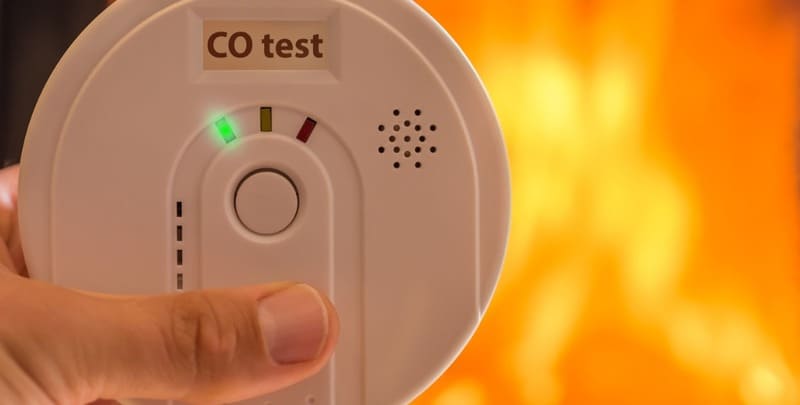
How Carbon Monoxide Testing Could Save Your Life
Now that we’re running our heating systems more frequently, it is important to think about the risks that carbon monoxide gas can pose.
Continual exposure to CO in significant amounts has harmful effects. Therefore it is necessary to perform carbon monoxide testing if you suspect you might have faulty gas appliances that could spring a leak. A carbon monoxide test will determine the presence (or lack) of the potentially lethal gas to ascertain whether you and your family might be vulnerable to carbon monoxide exposure.
How Does Carbon Monoxide Form?
Carbon monoxide (CO) is a colourless and odourless gas that forms with the incomplete burning of carbon fuels like natural gas, petrol, wood or coal. This is typically a result of insufficient oxygen in the burning process. Unlike carbon dioxide which is made up of one carbon atom and two oxygen atoms, CO consists of just one of each.
Several types of appliances that use these fuels can produce carbon monoxide, such as:
- stoves
- hot water systems
- gas and wood fireplaces
- grills
- generators
- power tools and
- motor vehicles
However, it is most commonly from carbon particles emitted from gas space heaters. The build-up can occur indoors and can poison both humans and animals. Outdoor heaters also produce carbon monoxide, but they typically present as less of a risk due to the adequate ventilation of the outdoor air.
How Does A Carbon Monoxide Test Work?
Carbon monoxide testing is essential for maintaining a safe home environment, particularly for those utilising gas appliances. We advise homeowners to utilise a carbon monoxide detector, a device that continuously monitors carbon monoxide levels in the home. The carbon monoxide detector has been around since 1993. Similar in appearance to a smoke detector, licensed gas fitters can easily install CO detector devices in your home as part of the CO testing process.
This is crucial in areas where a gas heater and hot water systems are in operation, as they can be potential sources of a carbon monoxide leak. To ensure comprehensive safety, always have a licensed professional test for carbon monoxide, particularly before the winter season when gas heaters are used more frequently. These detectors provide an audible alarm if unsafe levels of carbon monoxide are present, prompting immediate action to address any leaks. Regular maintenance of these appliances is paramount to prevent the silent threat of carbon monoxide poisoning.
Symptoms of CO Poisoning
The symptoms of carbon monoxide poisoning are similar to those of the flu. This is why many people miss the signs of CO poisoning. In addition to flu like symptoms, other possible indicators include:
- Dull headache
- Weakness
- Dizziness
- Nausea or vomiting
- Shortness of breath
- Confusion
- Blurred vision
- Loss of consciousness
- Chest pain
Because of the odourless nature of carbon monoxide, you may be unaware that your property has CO levels that are too high.

Who is at Risk Of Carbon Monoxide Poisoning?
In short, everyone is at risk of carbon monoxide poisoning when gas appliances leak carbon monoxide in the home. Nobody is immune to the “silent killer”. However, there is some evidence to suggest that those most susceptible to CO poisoning are individuals with breathing problems, the elderly, and infants.
Because of the undetectable nature of carbon monoxide emissions, falling asleep and being intoxicated in a CO heavy environment could be fatal. If you are worried about the risk of a carbon monoxide leak, you are much better off taking action sooner, rather than later.
Preventing Carbon Monoxide Leaks in Gas Appliances
The best place to start with reducing the risks of CO spillage in your home is to invest in battery-operated CO detectors and carbon monoxide tests. You can also increase safety with regular servicing of all gas appliances.
All new appliances should undergo gas appliance commissioning, where they are tested to ensure there are no leaks, they are well-ventilated, gas pressure has been set correctly, and more.
When purchasing a new gas appliance, you should be sure that it meets Australian standards and has a national testing agency seal.
What To Do If You Suspect a CO Leak
If you suspect a gas leak and can’t identify the source, get out immediately and contact a licensed gas fitter. At Metropolitan Plumbing, our plumbers operate 24/7, every day of the year and can even be at your door within the hour*.
If you know the source of your gas leak, turn off the gas-powered appliance if you can, until a professional can arrive to inspect it.
Properly venting your gas appliances is also an important measure to prevent trouble with carbon monoxide. Horizontal vent pipes for appliances allow CO to dissipate into air and outside your home.
It is important to never patch up a vent pipe with tape or foreign objects. This can cause CO to build up in your home because it has no way to escape.
Call The Experts in Carbon Monoxide Testing
When it comes to carbon monoxide leaks, it’s always better to be safe than sorry. Professional carbon monoxide testing is the best approach to take to ensure the safety of you and your family.
For more information about our carbon monoxide detection services and our gas appliance servicing, contact the team at Metropolitan Plumbing today.
Please note: This information is provided for advice purposes only. Regulations differ from state to state, so please consult your local authorities or an industry professional before proceeding with any work. See our Terms & Conditions here.
Published: 2020-06-17

















